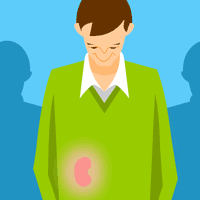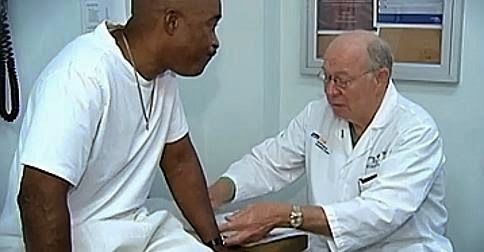South Florida leading Nephrology practice and Florida's ONLY Certified Hyperension Center, THE KIDNEY & HYPERTENSION GROUP, reports and discusses the latest news effecting your kidney and vascular health. Learn why we are the top rated kidney practice, every year, in every poll. (954)771-3929
Translate
University of Miami Miller School of Medicine Nephrology Faculty

Friday, May 29, 2015
Urine Tests Detects Cancer and Diabetes in Study
By Robert F. Service 28 May 2015 4:00 pm 3 Comments
Most of us think of bacteria as the enemy, but each of our bodies harbors trillions of microbes, most of them beneficial or benign. Now, you can add two new friendlies to the list. This week, two groups of synthetic biologists seeking to repurpose living microbes for human benefit report genetically modifying bacteria to detect cancer in mice and diabetes in humans.
Clinicians have sought to exploit microbes for more than a century. Beginning in 1891, an American bone surgeon named William Coley injected more than 1000 patients with bacterial colonies in hopes that they would shrink inoperable tumors. The treatment sometimes worked, in part because the microbes preferentially seek out tumor tissue, which is rich in nutrients yet has few immune cells to knock out any pathogens. But the results were uneven, and with the rise of radiation and chemotherapy, the approach fell out of favor. More recently, synthetic biologists have begun to modify bacteria to fight cancer and other diseases—engineering them to secrete toxins inside tumors, for example. A couple of these therapies have even made it into clinical trials, though none have been approved yet.
Far less effort has been directed at using bacteria as a test for disease. Sangeeta Bhatia, a biomedical engineer at the Massachusetts Institute of Technology (MIT) in Cambridge, and her colleagues previously worked on cancer detection using metal nanoparticles. In the presence of a tumor, the particles would release snippets of proteins called peptides that could be detected in the urine. Unfortunately, Bhatia says, the signal was often too weak to serve as a clear indicator of disease. Bhatia’s team then realized that bacteria offered a potentially superior option. The researchers knew that microbes with a taste for tumor often penetrate the masses as they grow and replicate. So Bhatia’s group joined up with a team led by Jeff Hasty, a bioengineer at the University of California, San Diego, to reprogram bacteria that could be fed to mice and, in the presence of cancer, would produce a luminescent signal with a simple urine test.
They started with a harmless strain of bacteria called Escherichia coli Nissle 1917, which is commonly added to yogurt and other foods as a probiotic to promote digestive health. First, they fed the bacteria to mice and confirmed that the microbes crossed the gut and colonized tumors in the liver. They engineered the bacteria to produce a naturally occurring enzyme called LacZ when they encountered a tumor. Next, the researchers injected mice with compounds that were precursors for light emitters. These were two-part molecules made up of a sugar linked to luciferin, a luminescent molecule. When bound together, the pair doesn’t emit light, but LacZ acts like a pair of scissors that cuts the two apart. So, in mice that had liver cancer populated by E. coli, the LacZ produced by the microbes released the luminescent compound, which was then excreted in the animals’ urine, turning those samples from yellow to red. What's more, Bhatia and her colleagues report in the current issue of Science Translational Medicine this week, while conventional imaging techniques struggle to detect liver tumors smaller than 1 square centimeter, this approach was able to flag tumors as small as 1 square millimeter.
In a separate study also reported in the current issue of Science Translational Medicine, researchers led by structural biochemist Jerome Bonnet of the University of Montpellier in France followed a related strategy to detect a key sign of diabetes, namely elevated glucose in the urine of human patients. The researchers added genetic circuitry to the bacteria so that they produced a large amount of a red fluorescent protein once the concentration of glucose in their surroundings reached a certain level. In this case, however, the team’s strain of E. coli wasn’t injected into people first, rather simply added to urine samples, where they produced a color change. For now, this approach isn’t any better than a standard glucose meter. But because the detection scheme can be repurposed to detect other targets, it could serve as a platform for a broad array of future diagnostics.
“They are both nice advances for the field,” says Jim Collins, a synthetic biologist at MIT. But he cautions that both approaches remain years away from being approved for clinical use. Tim Lu, also a synthetic biologist at MIT, agrees. “Taken together this pair of papers demonstrates that synthetic biology will be useful not only for therapeutics but diagnostics as well.” That might just give bacteria a good reputation after all.
Posted in Biology, Health
in Study
Subscribe to:
Post Comments (Atom)
Black Americans Are At High Risk of Kidney Disease. Click Picture To Learn What Can Be Done
Popular Posts
-
Causes of High Potassium High levels of potassium in blood cause a condition known as hyperkalemia. A kidney disorder is the major cause of...
-
LETTERS Kidney Warning (1 Letter) Published: August 13, 2012 To the Editor: Re “Transplant Centers Struggle With Donors’ Obesity” (Aug...
-
UCSF unveils model for implantable artificial kidney to replace dialysis UCSF researchers today unveiled a prototype model of the first i...
-
April is National Donate Life Month, and if you're thinking about donating a kidney, now would be the time to find out what it's all...
-
THE KIDNEY GROUP'S DR. GABRIEL VALLE HAS BEEN CHOSEN AGAIN TO "BEST DOCTORS" WHICH IS A WORLD CLASS PANEL OF EXPERTS, CHOSEN B...
-
You can't have a healthy heart without healthy blood pressure, so see your doctor or health-care professional for a reading. An accurate...
-
10 Facts (And Myths) About Lupus Lupus is a chronic, autoimmune disease that can damage any part of the body (skin, joints, and/or organ...
-
Several patients have called, alarmed with news reports that patients with #kidney stones face a higher incidence of end stage renal disease...
-
There's a dangerous health problem on the rise in the United States, affecting more than 20 million adults—25 percent more than a decade...
-
There's 3 TOP Nephrologists in Broward County..and you're looking at them! (L to R Drs. Gabriel Valle, Chief of Medicine, Holy Cr...
Post Titles
- "Kindest Cut" New Yorker 2009
- 10 TIPS FOR A HEALTHY BLOOD PRESSURE
- 25 Wonderful Years With Her Husband's Kidney
- A Diet That Works For Both Hypertension and Gout
- A Heartfelt Thank You
- AJKD ARTICLE ON HYPERTENSION IN DIALYSIS PATIENTS
- ALL ABOUT CKD
- All About Potassium
- An Inspiration to Patients Awaiting Transplant
- Barbara Kissane Valle
- Barbara Valle
- Becoming An Organ Donor Impacts Many Lives
- Being on multiple transplant lists makes sense
- BEJAR IPMC MVP CANDIDATE
- Broccoli For Preventing Hypertension
- Captain Ladino sent to Kosovo
- CARLOS BEJAR M.D. OF THE KIDNEY GROUP DISCUSSES PREVENTING DIABETIC KIDNEY DISEASE
- CDC Answers Questions on Ebola Safety
- Charlie debuts at the Kidney Group
- Cheetos lip balm curbing cravings?
- CNS
- Common High Potassium Foods
- Common Symptoms of Zika Virus
- Control your Blood Pressure Naturally
- Covid 19 vs Flu Pandemic of 1918
- Cranberry juice and UTI
- DANGERS OF VARIABLE BP
- David Kessler's book on" Junk Food Epidemic"
- DEATH OF DR. ROBERT GERONEMUS LEAVES VOID
- DEATH OF THOMAS HERRION RAISING QUESTIONS
- DEFINING HEMATURIA
- DESPERATE HOUSEWIVES TACKLES ESRD
- Determining Your Ideal Weight
- DIABETES MANAGEMENT IS KEY
- DIABETES MYTH #1
- Diabetes Tsunami
- Dialysis Catheters Increase Risk of Death
- dIALYSIS PATIENT STILL RACING HORSES
- DID CELEBRITY GET NATALIE COLE HER QUICK KIDNEY?
- DIET CAN LOWER YOUR RISK OF DIABETES
- DR OZ ON KIDNEY DISEASE
- Dr Valle Sweeps Top Doctor in Palm Beach and Broward Again
- Dr. Ameen Waheed to Chair UM Nephrotic Syndrome Symposium Section
- Dr. Bejar's new puppy
- Dr. Carlos Bejar
- Dr. Gabriel Valle and Dr. Carlos Bejar named Best Kidney Doctors in Palm Beach County
- Dr. Gabriel Valle and Dr. Carlos Bejar Named Top Doctors in Nephrology and Hypertension for 15th year in a Row
- DR. GABRIEL VALLE CHOSEN "BEST DOCTOR" AGAIN FOR 2011.
- DR. GABRIEL VALLE DISCUSSES FUTURE HOPE IN CKD
- Dr. Gabriel Valle Discusses Protein and Your Kidney
- Dr. Gabriel Valle has first patient accepted into Paired Donor Program at UM
- DR. GABRIEL VALLE NAMED TOP NEPHROLOGIST BY BOCA LIFE MAGAZINE
- Dr. Gabriel Valle Top Kidney Doctor 18th Year In A Row
- Dr. Jorge Ajuria is now a Fellow of the American Society of Nephrology
- Dr. Marco Ladino joins KidneyWorld Editorial Board
- ELEVATED BLOOD PRESSURE LEADING CAUSE OF EARLY DEATH
- EXPANDED DONOR CHOICES
- Expanded Transplant Options with The Kidney & Hypertension Group
- Expert Care
- FACE IT-WE'RE FAT
- Facebook for Kidney patients en Espanol
- FERNANDA'S OWNER HAS KIDNEY TRANSPLANT
- FIGURE OUT YOUR KIDNEY RISK
- Florida's Leading Peritoneal Dialysis Provider
- Follow the most popular Kidney Medicine practice on Facebook
- Fort Lauderdale's Kidney Group leads state in # of kidney transplants
- FRIEND DONATES KIDNEY TO LOCAL WOMAN
- Gabriel Valle M.D. Now Fellow of the ASH
- GEORGE LOPEZ TRANSPLANT PART OF A GROWING TREND
- Harvard
- He Got the Kidney
- High Potassium
- HISTORY OF CANCER DOES N'T PRECLUDE TRANSPLANT
- Home Dialysis
- HOME DIALYSIS OPTIONS
- How Does The Kidney & Hypertension Group Transplant So Many Patients?
- How To Prevent Kidney Stones
- IMPC MVP
- IMPORTANT INFORMATION ON PHOSPHORUS
- Improving Kidney Health at the KHG
- Infertility and Hypertension Link
- INSIDER TIPS ON GETTING A KIDNEY TRANSPLANT
- Insiders Tips on Getting a Kidney Transplant
- Juliette Valle is Miss Broward County's Outstanding Teen 2016
- KEEP YOUR KIDNEYS WORKING WELL
- Keep Your Potassium In The Normal Range With These Tips
- Kidney & Hypertension Group In Fort Lauderdale Voted Florida's Best Again
- Kidney and Hypertension Group has Florida's top Home Dialysis Program
- KIDNEY COSTS WILL CONTINUE TO SOAR
- KIDNEY DIVORCE WAR HEATS UP
- Kidney Docs Tell You 3 Easy Ways To PREVENT Kidney Stones
- Kidney Doctors Offer Same Dat Appointment
- KIDNEY GROUP DEBATES KIDNEY RATIONING
- KIDNEY GROUP KIDNEY-PANCREAS PATIENT WINS OLYMPIC GOLD
- KIDNEY GROUP PATIENT WINS GOLD AT TRANSPLANT OLYMPICS
- KIDNEY TRANSPLANT:THE KINDNESS OF STRANGERS
- Learn how to keep your kidneys healthy for life
- LETS TALK ABOUT A KIDNEY TRANSPLANT
- Lipid Management In Kidney Disease-New Guidelines
- Living Successfully With HIV and Kidney Disease
- LIVING WITH POLYCYSTIC KIDNEY DISEASE IN 2008
- LOOKING OUT FOR KIDNEY PATIENTS IN THE PANDEMIC THREAT
- Love is good for you
- LOWER YOUR BLOOD PRESSSURE WITHOUT DRUGS
- MAKE YOUR OWN LUCK IN GETTING A TRANSPLANT
- Marco Ladino of The Kidney Group in Fort Lauderdale wins award from Florida Society of Nephrology
- Medicine and Media
- Meet Dr
- Minimize Your Radiation Exposure During Pre Transplant Workup
- More Kidney Transplant Success Stories at The Kidney and Hypertension Group of South Florida
- NEPHROLOGIST GIVES KIDNEY TO WIFE
- Never mind your sign..what's your BUN?
- NO CLENCHED FISTS
- NOBODY KEEPS BABY IN A CHAIR
- Number 1 of the 6 Phases of Successful Weight Loss
- Our first kidney transplant of 2012
- PATIENTS CAN PREVENT MED ERRORS
- Peritoneal Dialysi patient loses 90 lbs in 6 weeks
- PERITONEAL DIALYSIS MAKES SENSE FOR MANY KIDNEY FAILURE PATIENTS
- Peritoneal Dialysis Nurse
- Plans for Artificial Kidney Unveiled
- PREDICTING ODDS OF TRANSPLANT SUCCESS
- PREGNANCY IN CHRONIC KIDNEY DISEASE-A REVIEW
- Preserving Residual Renal Function In Dialysis Patients
- PREVENTING DIABETES
- PREVENTING FALSELY ELEVATED POTASSIUM LEVELS
- Preventing Kidney Disease
- Prevention Of Kidney Disease Through Drinking More Water-A Study
- Professor Gabriel Valle Greets His Students
- Quality in Dialysis
- Rapheal Baez
- Rapid Response Clinic at the Kidney and Hypertension Group decreases hospital admissions and ER visits
- reachs pre-transplant weight goal
- RESTLESS LEGS SYNDROME
- Seeing a Nephrologist Early in The Course Of Kidney Disease Improves Outcomes
- SHALL WE ?
- SODIUM BICARB UPDATE FROM JASN
- STOP HYPERTENSION BEFORE IT STOPS YOU
- Stop today and think about your kidneys
- Taking A Correct Home Blood Pressure Reading
- Tenofovir Use and the Kidney
- THE FIRST TRANSPLANT-A BRAVE TWIN BROTHER DONATES
- The Health Ranger speaks out on Vitamin D
- The Kidney & Hypertension Group Doubled It's Office Space In Fort Lauderdale To Meet Patient Demand
- The Kidney & Hypertension Group-Kidney Transplant Advocates
- The Kidney and Hypertension Group is Named Top U.S. Hypertension Center
- The Kidney And Hypertension Group Now Offers Same Day Appointments For Urgent Care
- The Kidney Group Again Named Best Nephrologists in Broward County
- THE KIDNEY GROUP OF SOUTH FLORIDAS DOCTORS ALL CHOSEN AS TOP PHYSICIANS
- The Kidney Group-Florida's Top Nephrology Practice plans a 3rd office in Coconut Creek
- The Leading Cause of Kidney Failure
- The Secret Revealed
- THE SQUEAKY WHEEL GETS THE TRANSPLANT
- Thoughts on RPA 2011
- TOOLS TO HELP YOU REACH YOUR GOALS
- Top Kidney Care At Best Prices
- Top Kidney Doctors Are Also The Most Affordable"
- Top Kidney Doctors Come To Coconut Creek - Parkland
- Treating BK Virus After Kidney Transplant
- Treatment of Resistant Hypertension in South Florida
- Understanding the Stages of Chronic Kidney Disease
- Understanding Your Kidneys
- United States Oldest Kidney Donor
- UNTIL WE CONTROL DIABETES
- Update on Mary's kidney.
- Urine test for Cancer and Diabetes
- Vanessa Williams and Diabetes
- VIPKidney Health is Florida's Top Luxury Dialysis Provider
- VITAMIN D: KEY TO LONGEVITY?
- Weight Loss Surgery in Pre-Transplant Patients
- What a week-4 of Dr. Gabriel Valle's patients get kidney transplants at UM in one week
- What causes blood in the urine?
- WHAT CAUSES HIGH POTASSIUM?
- What dialysis method woudl your doctor choose for himself?
- What Is Calciphylaxis and What Can Be Done About It
- WHAT IS CKD?
- What Is Metabolic Syndrome
- WHAT IS PROTEINURIA?
- What PCP's Need To Understand About Peritoneal Dialysis
- WHO GETS THE GOOD KIDNEY?
- will present her abstract of Gastric Bypass Surgery in Peritoneal Dialysis Patients in San Antonio at The Annual Dialysis Conference
- World Kidney Day-Promoting Better Kidneys
- WORLD'S FIRST ORGAN DONOR DIES AT 79
- YOU CAN PREVENT DIABETIC KIDNEY DAMAGE
- You Need a PD Catheter or AV Fistula
- Young Adults and Hypertension
- YOUR BODY KNOWS ITS PERFECT WEIGHT. LISTEN TO IT.
- YOUR KIDNEYS AND ANTIBIOTICS
CONGRATULATIONS TO THE KIDNEY GROUP'S NEW TRANSPLANT PATIENTS

Van C. (Dr. Gabriel Valle's patient-kidney-University of Miami, Cathy O. (Dr. Carlos Bejar-Kidney at University of Miami),Will E. (Dr. Ajuria-kidney-Miami Transplant Institute;Bob I. (Dr. Valle's patient, University of Miami-Kidney), Orlando T. (Dr. Valle's patient, University of Miami, kidney), Sara A. (Dr. Valle's patient, kidney, University of Miami),Steve I. (Dr. Jorge Ajuria's patient, kidney, University of Miami),Sandy L. (Dr. Carlos Bejar's patient, kidney, University of Miami),KATHY C. (kidney-University of Miami, patient of Dr. Valle,MARTIN O. (Dr. Valle patient-Heart/Kidney -University of Miami), ROBERT I. (Dr. Valle's patient Kidney at University of Massachusetts), DREW P.(kidney-University of Florida),BILL L. (University of Florida-kidney), BARBARA L. (University of Miami-kidney), FRANCIS L. (kidney at U. of F.), JONATHAN I. (kidney-at U of F), THERESA L. (kidney-pancreas at University of Miami),JEFF T. (kidney at University of Florida), TERESA R. (kidney-University of Miami), JEANNIE O. (kidney-University of Florida), ELOISE O. (Univ of Florida), JOHN E. (kidney-University of Florida), GENE J. (Kidney-University of South Florida), CAL. M. (kidney- Florida Transplant Hospital in Orlando), TERRY A. (Perfect Match! University of Florida-kidney), TIM A.(kidney-University of Miami), GLORIA R. (kidney -University of Miami), BRAD R. (Kidney (and never on dialysis!!)-at University of Miami),(*both Brad and Gloria got kidneys on the same day!!!), BELINDA (kidney-University of Miami), TOM (kidney-University of Miami), JIM E. (Kidney-University of Miami), HERBERT A., (Kidney-University of Miami), Belinda R. (University of Miami-kidney),
PATRICK LOVES THE KIDNEY GROUP

THE DOCTORS OF THE KIDNEY GROUP
Living longer by living smarter.

find 20 minutes a day to meditate. It reduces stress, lowers blood pressure, and reduces signs of aging.









No comments:
Post a Comment